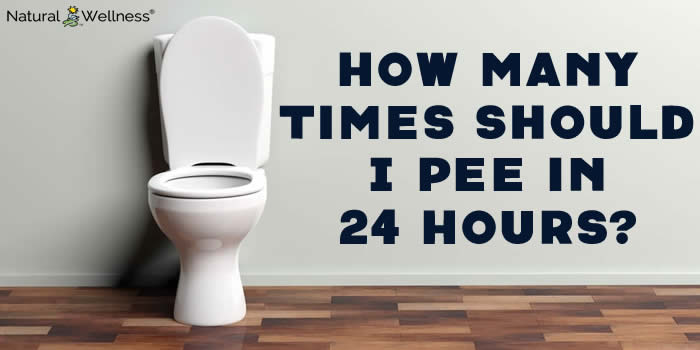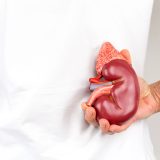

Peeing is a natural way for our bodies to expel waste and excess water. However, it becomes a concern when going to the bathroom too many times in a 24-hour time frame starts to impact your quality of life (4).
Peeing too frequently or changes in color or sensation during urination can indicate several different health issues. It could just be the result of drinking too much coffee, alcohol, or water, but other urinary issues can be more sinister, signaling larger problems elsewhere in the body (4).
That’s why it’s important to be able to distinguish between the two, detect symptoms early, and understand what exactly our pee is trying to tell you.
How Often Should You Pee During the Day?
As a general rule of thumb, normal is subjective, but when it comes to urinating, most sources will give a window between 4-10 times per day as the baseline for most “normal” adults (1).
If you’re reading this and asking yourself “Is it normal to pee every hour?” The answer is, no. And you should definitely examine your liquid intake and consult your doctor or urologist.
As we age, we tend to go more frequently and eventually lose control of the muscles in our pelvis that allow us to voluntarily control urinating. If you’re going pee more than 10 times a day, again, it’s time to book that appointment and consider a few strengthening exercises or using supplements to help control your bladder and urinary tract.
How Often Should You Pee at Night?
Ideally, not at all. Having to get up to go to the bathroom can interrupt your natural sleep cycle and most adults should be able to get a full 6-8 hours of sleep without needing to urinate (1).
Reasons for needing to pee overnight may be as benign as excess liquid intake before bed, or as serious as a bladder or urinary tract infection.
As we examine the mechanisms that cause the sensation of needing to go to the bathroom and how those mechanisms affect frequency and color, we’ll shed light on a handful of the most common reasons why you may feel like peeing too often and what you can do to help.
4 Reasons You Might Pee More Frequently
Below are some of the more common and general factors that can affect why most people start going pee more frequently:
- Age – Being over 40 puts most men at a higher risk for prostate issues (5). As we age we also lose strength in the pelvic muscles that help control our bladders and urinary tract. The ability to fully empty the bladder may also be lost, and present some health complications.
- Bladder size – Some people have naturally small bladders that don’t hold as much liquid. This can lead to an overactive bladder, nocturia or incontinence in some cases. Overactive bladders are most common in women (4).
- What, and how much you drink – Certain liquids like caffeine and alcohol are particularly difficult for our bodies to break down and can significantly darken the color of urine. Dark urine can also be a sign that you aren’t drinking enough water (4).
- Other conditions and medications – Type-2 diabetes and urinary tract infections (UTIs) in both men and women can cause frequent or painful urination and, if untreated, can lead to bladder infections like cystitis (3). UTIs can affect men and women in the form of inflammation to the urethra, bladder, ureter, or kidneys. Some blood pressure medications, diuretics, and supplements can also change urine color and frequency.
Some diuretic brands may change urinary routines such as Diuril, Thalitone, Microzide, Bumex, Lasix, Demadex, Midamor, Inspra, Aldactone, and Dyrenium (6).
If one or several of the above scenarios describes you, and if you’ve ever felt like going pee is interrupting certain aspects of your life, it may be time to start examining a number of other, larger health issues that could be the culprit.
Some of the more serious conditions associated with urinary problems are below.
Prostate Problems
When it comes to urine, disruptions often indicate problems in other larger areas of the body, like the prostate gland in men. If you begin experiencing any of the following, it may be a sign you have benign prostatic hyperplasia which is an age-associated, non-cancerous prostate gland enlargement (2). Prostatitis is another ailment involving the swelling or inflammation of the prostate gland.
Both benign prostatic hyperplasia and prostatitis share these 7 common symptoms:
- Difficulty starting a urine stream
- Having a weak or interrupted urine stream
- Excessive dribbling at the end
- Nocturia (frequent unintentional urination at night)
- Urinary incontinence
- Pain during urination
- Urine with an unusual color or smell
Benign prostatic hyperplasia happens most commonly in men over 40 who may also deal with type-2 diabetes, obesity, erectile dysfunction, cardiovascular or circulatory disease, or those who lead a sedentary lifestyle (2).
Type-2 Diabetes
Traditional signs of diabetes include feeling overly thirsty and experiencing increased frequency in urination. Diabetes manifests in our bodies when excess glucose, a type of sugar, builds up in the blood and our kidneys can’t keep up in processing it (7). As a result, the excess is excreted into our urine, dehydrating the rest of the tissue along the urinary tract in the process (7).
Bladder Stones and Blood
When urine is a dark orange or yellow it can be an indication of blood being present, which is never a good sign (5).
In women, overly frequent urination may be a sign of bladder stones and the two symptoms may be connected. Bladder stones form when the bladder isn’t emptied fully and minerals are left to collect (5). Some bladder stones pass naturally, while others may lead to infections if left untreated. The primary signs of bladder stones are discomfort or pain while urinating along with darker urine or blood in the urine (5).
Being Proactive
Consult your doctor or urologist if you begin experiencing any of the above symptoms.
Sometimes it’s hard to tell when subtle changes start to occur, which is why it’s good to err on the side of caution and be aware of both large and small urinary issues.
And whether or not symptoms have been experienced, men should take proactive steps in protecting their prostate’s health. This can easily be done by using a supplement like specifically formulated for prostate health.
Other proactive measures that work for both men and women include doing exercises to strengthen your pelvic floor, drinking cranberry juice or supplementing with cranberry pills to prevent UTIs, and taking supplements that help keep your urinary tract healthy. Exercises and supplements can be a powerful and inexpensive combination to address or prevent urinary and bladder issues.
Conclusion
The sensation of needing to go is our body’s natural way of telling us there’s something that needs to get out. However, the frequency, color, and sensation of elimination can help us glean necessary insight into our health.
If you have an overactive bladder and it starts to have an effect on your daily routine, it’s probably time to schedule an appointment with your doctor.




